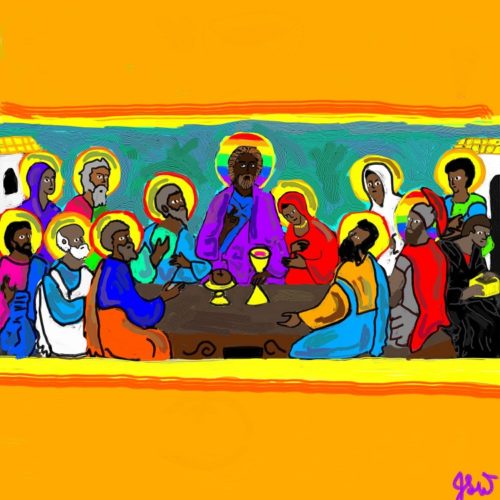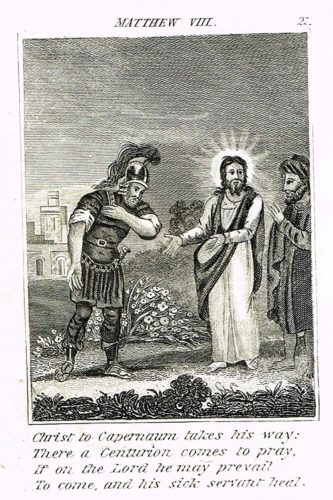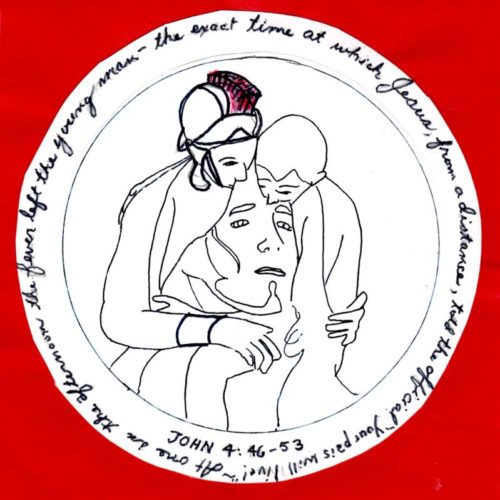
Jesus praised a gay centurion in the Roman army as a model of faith and healed his male lover in the gospels, according to some Bible experts. The soldier is highlighted here today (March 15) for the feast day of Longinus, a centurion at the crucifixion of Jesus.
Both Matthew 8:5-13 and Luke 7:1-10 tell how a centurion asked Jesus to heal the young man referred to in Greek as his “pais.” The word was commonly used for the younger partner in a same-sex relationship. It is usually translated as boy, servant or slave. In recent years progressive Bible scholars have concluded that the centurion was in a homosexual relationship with the “slave who was dear to him” in the gospel story. However being gay today implies an egalitarian relationship, while the centurion and his pais were obviously unequal male partners, as was common at the time.
![]()
“Healing the servant of the Centurion” is a fresco from 1547 at Dionysiou Monastery, an Eastern Orthodox monastery on Mount Altos in Greece
Jesus was willing to go into the centurion’s house to heal his lover, but the centurion stopped him, saying, “Sir, I am not worthy to have you come under my roof. But just say the word, and my servant will be healed. For I myself am a man under authority, with soldiers under me. I tell one to go, and he goes; and another to come, and he comes. I tell my servant to do something, and he does it.” During the coronavirus pandemic, this long-distance method might be called “social distancing.” Jesus saw it as an act of great faith.
Jesus marveled and told the crowd around him, “Not even in Israel have I found such faith!” To the centurion he said, “Go; be it done for you as you have believed.” And his boyfriend was healed at that moment.
While the faithful centurion himself is rarely mentioned, his words do live on in a prayer used in many Catholic and Protestant eucharistic liturgies. For example, every day millions of Catholics around the world echo his words in the prayer immediately before communion at Catholic mass: “Lord I am not worthy to receive you under my roof, but only say the word and my soul shall be healed.”
March 2022 update: New Centurion art added
Two new artworks are added in 2022 for the centurion’s feast day: “Centurion and his Pais” by Aaron Holloway and “Do This in Remembrance of Me” by Jeremy Whitner.
“Centurion and his Pais” by Aaron Holloway appears at the top of this post. The mixed emotions of homoerotic love between a soldier and his servant are expressed with stark clarity in the photo by Holloway, an Australian photographic artist living in Germany. The inequality of their social positions is expressed in their physical stance: The centurion sits on a chair in his armored military uniform, minus the helmet, with one hand on his sword and the other hand caressing his lover’s head. The nearly naked pais rests on the floor with his head in the centuion’s lap. He clings to the centurion’s ankle, but the glum expression on the face of the pais suggests that he may be a less than enthusiastic participant in their sexual games — or perhaps he is just sick and in need of healing. Holloway’s work is online at adavidhollowayart.com and saatchiart.com/A.DavidHollowayArt.

“Rainbow Centurion and Jesus” by Jeremy Whitner
In a colorful new painting by queer Christian iconographer Jeremy Whitner, the centurion has a rainbow halo to indicate his connection to the LGBTQ community as he asks Jesus to heal his same-sex lover. Jesus also has a rainbow halo, inspired by the Rainbow Christ Prayer that reveals the many faces of the queer Christ. Whitner is in process for ministry with the Disciples of Christ and attends Union Presbyterian Seminary in Charlotte, North Carolina.

“Do This in Remembrance of Me” by Jeremy Whitner includes the centurion with a rainbow halo.
The centurion appears again in Whitner’s vision of the Last Supper. He places the centurion is among the disciples in “Do This in Remembrance of Me.” The centurion can be identified by his rainbow halo and the red crest on top of his helmet. It’s unusual to picture the centurion at the Last Supper, but Whitner believes he joined the other disciples at the Passover meal because of his faith in Jesus. “When I consecrate communion I always make of point of saying the centurion was probably there, along with the woman with the issue of blood,” Whitner told Q Spirit.
Centurion’s story can affirm LGBTQ people
Scholars believe that “boy” was the centurion’s sex partner not only due to the word “pais,” but also because it is unlikely that a soldier would care so much about an ordinary slave. It was common in Greco-Roman culture for mature men to pair up with a young man as his lover in “erastes-eromenes” pederastic sexual relationship.
This interpretation is promoted by LGBTQ-friendly church groups such as WouldJesusDiscriminate.org on billboards stating “Jesus affirmed a gay couple.” For more info, see my previous post, Billboards show gay-friendly Jesus.

Scholars also note that any relationship between an adult soldier and his “boy” or “slave” is inherently asymmetrical, not a partnership of mutual equality. Christopher B. Zeichmann, New Testament instructor at the University of Toronto, writes about it as “a text of queer terror” in the context of “the rape culture of antiquity.”

An 1839 copper engraving of the Centurion asking Jesus to heal his servant appears in “Miller’s Scripture History,” published by J. Rider. An original print was available at Amazon. The poem below the image reads: “Christ to Capernaum takes his way: There a Centurion comes to pray, If on the Lord he may prevail To come, and his sick servant heal.”
The centurion’s story has gotten surprisingly little attention throughout history considering that Jesus himself was impressed by his faith. But the Roman soldier has always been an unlikely role model. Jesus’ contemporaries were probably shocked that the great healer would praise a military man who enforced Roman occupation of their land. Today people may find the centurion unappealing because he may have been queer, or a slave owner, or both. It was just like Jesus to take someone disreputable and praise them as holy.
The centurion says, “Speak the word only, and my servant shall be healed” in a page from the 1914 edition of Bible Readings for the Home Circle. The original page was available at the Things Are So Lovely shop on Etsy.
Saint Longinus, whose feast day is March 15, is the centurion who pierced Christ’s side at the crucifixion and declared, “Truly this man was the son of God.” It’s possible that he is the same faithful gay centurion whose beloved boyfriend was healed by Jesus.
Artists and writers portray the gay centurion
Artists have also tended to overlook the gay centurion’s story. Vintage Bible books are a good place to find images of the centurion asking Jesus to heal his “servant.” Some contemporary LGBTQ artists are also presenting the scene.

Detail from “Healing the Centurion’s Servant” in Mother Stories From the New Testament by Anonymous, 1906
Gay New Zealand artist Christopher Olwage pictures the centurion and his “pais” with Jesus at the cross in his 2015 crucifixion painting. The scene is framed by a male couple: the centurion on the left and the man “who was dear to him” on the right. The nude painting includes two other men who may have had male-male sexual relationships with Christ: John, who is most often identified as the Beloved Disciple and Lazarus. For more info, see the previous post Gay Jesus painting shown in New Zealand.

“Crucifixion” by Christopher Olwage (oil on canvas)
Jesus’ healing interaction with the same-sex couple has fascinated artist Eric Martin so much that he created two works based on their story. Martin (1960 – 2017) was a gay poet, artist, and church organist in Burlington, North Carolina. He earned a Master of Divinity degree from Southeastern Baptist Theological Seminary in Wake Forest, NC.

“Traces of His Presence” by Eric Martin
“Traces of His Presence” uses fluid lines and bold red to reveal the face of Christ in the holy space between the centurion and his beloved.

“The Visit” by Eric Martin
Martin takes a more realistic approach in “The Visit.” A rainbow arches behind Jesus as he gazes at the centurion and his pais. Their varied expressions draw the viewer deeper into the drama.
Sexual expression of a centurion’s love for Jesus is also the theme of “The Love That Dares To Speak Its Name” by British writer James Kirkup, the poem that led to a notorious trial and the last blasphemy conviction in Britain. Written from the viewpoint of a centurion, it graphically describes him having sex with Jesus’ corpse after his crucifixion and claims that Jesus had sex with other men, including his disciples, guards and Pontius Pilate. Gay News published the poem in 1976 and its editor, Don Lemon, became the last person convicted of blasphemous libel on July 11, 1977. Since then the poem has been made available by other publishers and public readings, but it is still technically illegal to publish the poem in the United Kingdom.
The centurion speaks his queer love and faith this way in the last lines of the poem:
And after three long, lonely days, like years,
in which I roamed the gardens of my grief
seeking for him, my one friend who had gone from me,
he rose from sleep, at dawn, and showed himself to me before
all others. And took me to him with
the love that now forever dares to speak its name.
Books that explore the homosexuality of the gay centurion
Jonathan Loved David: Homosexuality in Biblical Times by Tom Horner
Freedom, Glorious Freedom: The Spiritual Journey to the Fullness of Life for Gays, Lesbians, and Everybody Else by John McNeill
The Children Are Free: Reexamining the Biblical Evidence on Same-sex Relationships by Jeff Miner and John Tyler Connoley
What the Bible Really Says about Homosexuality by Daniel Helminiak
The Man Jesus Loved: Homoerotic Narratives from the New Testament by Theodore Jennings

“Jesus Heals a Centurion’s Servant” by Paolo Veronese (1528-1588) (Wikimedia Commons)
Links related to the gay centurion
A gay centurion comes out to Jesus (Gay Christian 101)
Jesus and the centurion (Wild Reed)
Gay centurion (My Queer Scripture)
Jesus, the centurion, and his lover (Jack Clark Robinson at Gay and Lesbian Review)
When Jesus Healed a Same-Sex Partner by Jay Michaelson (Huffington Post)
“The Centurion’s Servant” painting by British artist Stanley Spencer, 1914
El centurión gay: Jesús cura al novio de un soldado romano en la Biblia (Santos Queer)
___
Top image credit: “Centurion and his Pais” by Aaron Holloway. His work is online at adavidhollowayart.com and saatchiart.com/A.DavidHollowayArt.
___
This post is part of the LGBTQ Saints series by Kittredge Cherry. Traditional and alternative saints, people in the Bible, LGBTQ martyrs, authors, theologians, religious leaders, artists, deities and other figures of special interest to lesbian, gay, bisexual and transgender and queer (LGBTQ) people and our allies are covered.
This article was originally published on Q Spirit in March 2017 and was updated for accuracy and expanded with new material on March 15, 2022.
Copyright © Kittredge Cherry. All rights reserved.
Qspirit.net presents the Jesus in Love Blog on LGBTQ spirituality.

Posted on September 20, 2022
0